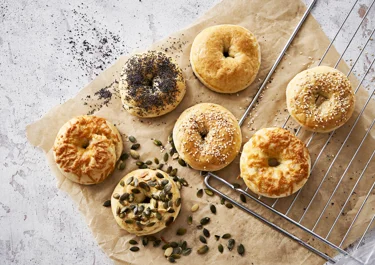
Bagels

Instructions
Bagels:
Boiling and baking bagels:
Tip
Even when properly stored, homemade and store-bought bagels alike may become a bit hard if they are not eaten the day they are boiled and baked. To ensure the perfect combination of chewy and soft that bagels are known for, you can soften and rehydrate them.
Tip
Stale or hard bagels may be revived by being rehydrated. If you are toasting a bagel in an oven, run hot water over it until its outside is damp but not soaked and heat it on a wire rack for 5 minutes at 180°C. You can also reheat your lightly damp bagel in a microwave to the same effect. Wrapping it in a damp paper towel rather than running water over it will also work.
Questions about bagels
With our easy bagel recipe, you can make sure that you always have either freshly baked bagels or frozen ones at hand. Read on to learn a bit more about the beloved baked good by having a look at our answers to some of the most frequently asked questions.
Ingredients
Bagels:
Milk (approx. 37°C) | 250 ml |
|---|---|
Yeast | 25 g |
Flavour-neutral oil, such as rapeseed oil | 1 tbsp |
Sugar | 1 tbsp |
Coarse salt | 1½ tsp |
Wheat flour (approx. 7 dl) | 400 g |
Brushing:
Beaten eggs |
|---|
Sprinkling:
Shredded red cheddar cheese, some sesame seeds, blue poppy seeds, or pumpkin seeds | 50 g |
|---|
Homemade chewy bagels
If you enjoy a baked good with a chewy, slightly crisp crust that is soft and dense on the inside, you may be a bagel lover. Though these golden rolls with a hole in the middle were originally made in Jewish communities in Europe, they are popular around the world. The bread type has great textures and a neutral flavour that makes it highly suitable for a vast array of different toppings.
After reading our description of how delicious bagel bread is, you may be thinking ‘but what can I put on a bagel?’ The answer is almost anything you desire! As a quick breakfast or snack, homemade bagels taste great with butter, flavoured cream cheese, peanut butter, hazelnut spread, or fruit preserves like blackberry jam. For a more indulgent breakfast, try serving them with eggs, bacon, and cheddar cheese or a fried egg and slices of avocado. A bagel is also delicious as a light lunch dish with tuna salad, egg salad, or the classic New Yorker combination of cream cheese and smoked salmon.
Boiling and baking to get the perfect texture
Making bagels involves both boiling and baking the dough to ensure a dense, yet soft, inside and a chewy outside with a shiny coating. The reason you will want to boil bagel dough is that this sets and cooks the crust before they are baked, meaning they better hold the shape. If boiled briefly, as we suggest in our soft bagel recipe, the crust will be thin and somewhat elastic, meaning that each bagel will still be able to rise slightly as they bake. Boiling them for longer makes the crust thicken, which in turn makes the interior denser because they cannot rise as much.
Boiling bagels is quite simple. Make sure to boil them a few at a time so you avoid lowering the temperature of the boiling water too much. Adding ingredients such as sugar, honey, or barley malt to the water will make the exterior even more golden and crispy due to caramelisation.
Delicious bagel toppings
Bagel bread tastes wonderful with an array of different toppings. Our simple bagel recipe toppings include classic choices like grated cheddar, sesame seeds, poppy seeds, or pumpkin seeds. Topping a homemade bagel with grated cheddar gives it a delicious, decadent, and slightly crunchy cheese crust. If you enjoy nutty flavours, experiment with topping them with different seeds. Black and white sesame seeds provide a toasty, nutty flavour that becomes more pronounced as they bake, while poppy seeds add a lovely crunch. Pumpkin seeds may also add crunchiness as well as a subtle nutty flavour. Mix and match these classic topping options after brushing your bagels with egg wash so the toppings may better adhere to them.
Add your own touch
Our homemade bagel recipe gives you ample opportunity to experiment with the toppings as well as the bagels themselves for example by turning the recipe into a mini bagel recipe. Making about 12-14 mini bagels instead of 8 regular ones gives you cute, little treats that are perfectly snack-sized, a great surprise in any lunch box, or a fun slider-like entrée at dinner parties. You can also experiment with mixing wheat flour with other flour types like wholemeal and rye or using sourdough as a leavening agent instead of yeast.
In respect to toppings, making a so-called ‘everything bagel seasoning’ with nutty sesame seeds, crunchy poppy seeds, dried minced garlic and onion, and flaky sea salt to enhance the delicious onion flavours is a classic savoury option. A traditional sweet alternative is to add 1 teaspoon of warming cinnamon to the dough and top the boiled bagels with a crunchy cinnamon topping made from butter, dark brown sugar, and cinnamon. A sweet and cinnamon-flavoured bagel such as this one also tastes great with raisins for additional texture and chewiness.










